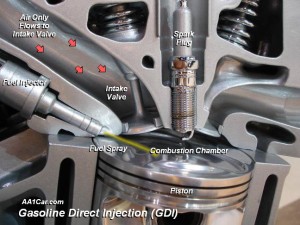Here’s the latest reader question, along with my reply!
William asks: I finally found what I thought was a decent deal on a used Nissan Titan and had a question about something a salesman told me. I mentioned that I was aware the Nissan V8 was direct injection but since I had 33 months left on the warranty I wasn’t overly concerned. He told me as long as I used “good” gas, i.e., Shell, Exxon, BP etc. and didn’t use Wawa, Costco, Sheetz, etc. I would be fine. Any opinion on this? I know you have a couple of Nissans and after the test drive of the Titan, I was pretty much sold. Thanks again for your great content as I have learned a lot.
My reply: Some brands of gas do have different (and possibly, better) additive packages and some gas stations have fresher gas due to heavier traffic. Both will help avoid fuel-system problems such as clogged injectors. But “good” gas can’t do much to keep valves from carbon fouling in a DI engine because the fuel is directly injected into the cylinders and so there is no solvent effect. The valves run “dry” – and that is the source of the carbon fouling problem – or potential problem – with DI engines. Several manufacturers have added a separate port-injection circuit solely to deal with this problem. I think it’d be better to just ditch the DI system and go with PFI. Or even TBI – which is simpler and provides almost exactly the same advantages to the owner – such as quick/easy starting in all weather, no stalling; automatically maintains ideal A/F ratio, etc. – but at much lower cost both up front and in terms of repairs down the road.
DI is a much more complex and so potentially expensive system than PFI (and TBI). There are two fuel pumps and the system runs at extremely high pressure. There are few advantage that I can see for the vehicle’s owner vs. PFI and several disadvantages, including the potential for carbon fouling at relatively low mileage and then possibly having to do a top-end teardown to clean the crud.
DI has been adopted almost industry-wide because it provides a slightly cleaner burn and so a slight reduction in emissions and a slight increase in fuel economy – both things too slight (or even noticeable, in the case of emissions) to be of any concern to the buyer but both are huge concern to the car companies, who must “comply” with regulatory ukase.
You might have a look at the Toyota Tundra – which still has a PFI V8. It’s a great truck, too. I’m not crapping on the Nissan, incidentally. It’s also a great truck. But it might be worth at least checking out the Tundra…
. . .
Got a question about cars, Libertarian politics – or anything else? Click on the “ask Eric” link and send ’em in!
If you like what you’ve found here please consider supporting EPautos.
We depend on you to keep the wheels turning!
Our donate button is here.
If you prefer not to use PayPal, our mailing address is:
EPautos
721 Hummingbird Lane SE
Copper Hill, VA 24079
PS: Get an EPautos magnet (pictured below) in return for a $20 or more one-time donation or a $10 or more monthly recurring donation. (Please be sure to tell us you want a sticker – and also, provide an address, so we know where to mail the thing!)
My latest eBook is also available for your favorite price – free! Click here. 












If fuel injection had never “progressed” beyond TBI, we’d all be much better off for it. After all, once gas is turned into a mist, it’s the intake and heads that make the power. Now we’re finding engine manufacturers who make a combo engine of old school SBC with LS heads. A friend set one up that way long ago. It had none of the problems of the LS but made a lot of power and got great fuel mileage.